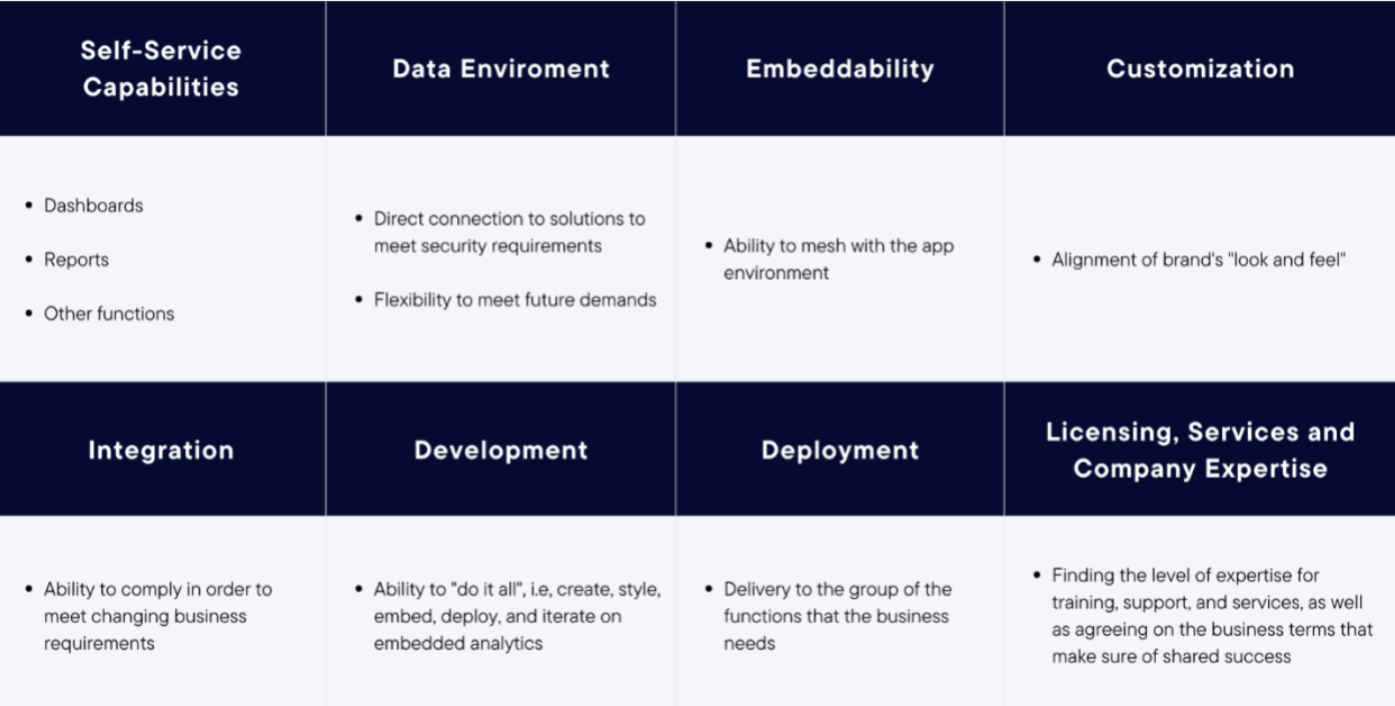Your Path to Finding the Best Embedded Analytics Solution

Your customers are increasingly turning to analytics to add value for their end users. Choosing the right solution—one that will continue to differentiate you from competitors—is no easy task. If your clients aren’t equipped with the right analytics, chances are that their stakeholders lack key evaluations. Improper insights into their data can hamper success at their journey’s end.
5 Signs That Now Is the Time for an Analytics Upgrade
Outdated analytics features make it impossible to keep your end users engaged, upsell your existing customers, or win new ones. And because it’s a pain for your development team to manage, it affects the rest of your product—taking resources away from revenue-driving innovation elsewhere.
How do you know it’s time to replace your embedded analytics? Look for these 5 signs:
1. Demand for new capabilities: If your users demand advanced capabilities and self-service analytics, using basic dashboards and reports may lead to increased customer churn. They expect features like embedded self-service analytics, write-back, and workflow capabilities to seamlessly integrate with their other tools. If your outdated analytics can’t meet these modern BI demands, consider finding a third-party tool to avoid the pains of building it from scratch.
2. Painful scaling: As your end users demand more features, your development team will struggle to keep up. If you continue to build analytics with components, you’ll be forced to research and develop each new capability, one at a time. This will unavoidably delay every product update. Every new feature takes exponentially more time and resources to deliver.
3. Security inefficiencies: In addition to the risks posed to your data, outdated security integration means that user management can quickly snowball for your development and IT teams. There’s no way to globally manage security with components, which means you’ll have to implement and maintain security separately and consistently for every component you use.
4. Time: For most software teams, time constraints are a major concern. Developing and maintaining homegrown analytics diverts focus from their core application. Updating or changing analytics components requires significant time and effort, leading to delays in adding value to the product.
5. Cost: Sticking to the “build” track means dealing with increasing costs over time. As technology evolves, maintaining the analytics component becomes a continuous investment. Ensuring usability and stability after launching your application requires ongoing time and resource allocation. Additionally, using component libraries may lead to compatibility and versioning challenges, causing potential regression issues with upgrades.
Build vs. Buy: 10 Hidden Costs of Building Analytics With UI Components
Download NowBuild or Buy at a Glance
A key decision on the path to your next analytics solution is whether to build or buy. Here’s both routes in a nutshell:
Building: While the in-house route gives you total control over the project, like its scope, budget, and timeline, it does so at a cost. According to ESG, developing an in-house embedded analytics solution could take up to 20% of your resources over three months. Of course, this figure assumes your analytics solution isn’t delayed and doesn’t require more resources, so there is considerable margin for error. Companies traditionally build their own analytics solutions when they:
- Have significant IT resources to build, test, correct, and maintain an analytics platform.
- Have a flexible schedule, or their time to market isn’t a priority currently.
- Only need basic reporting tools and a UI with limited functionality.
Buying: With outsourced analytics solutions, there’s no need to worry about product maintenance, training, or documentation, since vendors extensively document their platforms. Instead, your software has analytics available to internal users at a moment’s notice that is ready to scale with their needs. What’s more, you can reinvest the time and cost savings into more productive or pressing business areas and maximize your developers’ potential. Firms turn to commercially available solutions when they:
- Need a competitive BI tool on a tight timeline.
- Need their analytics to scale reliably with their app or software.
- Can’t let future integrations, feature upgrades, or security flaws from third-party UI components risk their app or software crashing.
Clearly, buying has more and better pros than building.
How to Find the Perfect Solution for Your Embedded Analytics?
So, you’ve decided to invest in an embedded analytics solution, rather than building it. Great! So, now what? You will need to figure out which vendor is the best fit for your business.
Let’s start by examining the list of requirements and features that are critical to this assessment. These are the most common:
Choosing the right solution involves a great deal of research. This includes three steps, (1) assessing the technology, (2) understanding the expertise of the vendor, and (3) putting together an A-to-Z plan for success.
First, we will provide more detail about the evaluation criteria. Then, we will walk through the entire process for an end-result that is successful.
- Self-service capabilities are at the top of the list of important features for the end-users of your app. Make sure that the capabilities important to your project are front and center. Plan how you will deliver and iterate these within your application.
- Make sure your data environment is good-to-go. Meaning, the solutions you think about should mesh with your current data architecture. These must be flexible enough to meet the changing demands of users.
- Launch plans for embedded analytics vary from that of traditional BI. The former places more of an emphasis on the ability to integrate and customize. Application providers often want to offer a smooth user experience and one that is like its existing app and brand. A laser focus on enhancing the value of your application while at the same time, reducing the cost of development.
- Time-to-value is so critical to the success of the project. Having an environment where you can create, style, embed, and deploy analytics is crucial. With these, your team will be able to deliver the functionality that your business demands.
- Choosing the right partner is not just about the technology. It’s about finding the right level of expertise and team commitment to get you to the finish line (and beyond). Some reminders:
- Be sure the licensing terms make business sense in the short and long term.
- Assess the range of professional, technical, and training services.
- Inquire of your vendor’s experiences and expertise in making others like you successful.
Choosing the Best Embedded Analytics Vendors for your Business
Now that we’ve figured out the criteria for comparing vendors, let’s look at how to choose the best one for your business.
1. Determine Your Goals
To get where you want to go, write it down. Increase your likelihood of success simply by putting your goals on paper. Think quantitative and qualitative.
2. Establish the Timeline
Identify the steps you’ll take to reach your goals.
3. Assemble the Team
Pick the stakeholders who need to be involved. Who is going to care about embedded analytics inside and outside the business?
4. Plot Requirements
Review your requirements. Weigh the importance of each.
5. Research Vendors
Assess which vendors’ functionality matches your must-haves. Use independent industry resources, such as the 2023 Wisdom of Crowds® Business Intelligence Market Study report. This will help build your initial list.
6. Complete Technical Evaluations with a Select Few
Narrow down your list to the top two or three vendors. This is where you’ll want to establish clear-cut guidelines for what you want to accomplish within a reasonable timeframe of, say, thirty days.
7. Talk to References
Look for references that are similar (in terms of size, industry, use case, etc.) to your organization.
8. Select a Vendor and Get Started
It’s go time! Choose the vendor with whom you feel most confident as a partner to reach your goals. Look beyond software and focus on the vendor who gives you the highest chance of success.
9. Monitor, Adapt, and Optimize
After three to six months, do a check-up and consider reengaging with your vendor’s services. Assess additional services that could take you to the next level.
Final Steps
At this final stage, a vendor has been selected. Congratulate the team on a job well done as it can be a lengthy process, but it will be worth it in the end.
One point is for certain. In the realm of analytics, change is ongoing. Your users will demand more, and it will be up to the technology and customer success teams to create and deliver better and quicker. Ultimately, you want to bring the most value to your application, your business, and your users.
Your vision is clear. You know precisely what to do and the detailed steps to follow. It is time to kick off your mission and begin your search for a vendor that specializes in embedded analytics. ‘
Logi Embedded Analytics: Purpose-Built for Software Teams
Logi Symphony offers an end-to-end Business Intelligence and Analytics platform explicitly designed for embedding. Logi Symphony enables software teams to connect to any data source, manipulate and structure their source data, and rapidly design, customize and embed Business Intelligence (BI) / Analytics content into other applications.
- Logi Symphony offers unrivaled flexibility for the visual customization of dashboards and reports.
- Full API support enables a deep level of embedding and application customization.
- Logi Symphony offers an end-to-end BI platform to allow clients to embed any desired reporting vision within their application.
Start off on the right foot by requesting a demo of Logi Symphony, today.

